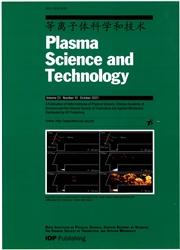Ion heat transport in electron cyclotron resonance heated L-mode plasma on the T-10 tokamak
IF 1.8
3区 物理与天体物理
Q3 PHYSICS, FLUIDS & PLASMAS
引用次数: 0
Abstract
Abstract Anomalous ion heat transport is analyzed in the T-10 tokamak plasma heated with electron cyclotron resonance heating (ECRH) on second harmonic extra-ordinary mode. Predictive modeling with empirical scaling for Ohmical heat conductivity shows that in ECRH plasmas the calculated ion temperature could be overestimated, so the increase of anomalous ion heat transport is required. To study this effect two scans are presented: over the EC resonance position and over the ECRH power. EC resonance position varies from high field side to low field side by variation of toroidal magnetic field. Scan over the heating power is presented with on-axis and mixed ECRH regimes. Discharges with high anomalous ion heat transport are obtained in all considered regimes. In these discharges power balance ion heat conductivity exceeds neoclassical level up to 10 times. High ion heat transport regimes are distinguished by three parameters: T e /T i ratio, normalized electron density gradient R/L n e , and ion-ion collisionality ν ii ∗ . Combination of high T e /T i , high ν ii ∗ , and R/L n e =6-10 results in values of normalized anomalous ion heat fluxes up to 10 times higher than in low transport scenario.T-10托卡马克上电子回旋共振加热l模等离子体中的离子热输运
摘要研究了电子回旋共振加热(ECRH)在二次谐波超常模式下加热T-10托卡马克等离子体中的异常离子热输运。基于经验标度的化学导热预测模型表明,ECRH等离子体中计算的离子温度可能被高估,因此需要增加异常离子热输运。为了研究这种影响,提出了两种扫描:EC共振位置和ECRH功率。环向磁场的变化使EC共振位置从高场侧到低场侧发生变化。对加热功率的扫描显示为轴上和混合ECRH状态。在所有考虑的状态下都获得了高异常离子热输运放电。在这些放电功率平衡中,离子热传导率超过新古典水平高达10倍。高离子热输运机制由三个参数来区分:T e /T i比、归一化电子密度梯度R/L n e和离子-离子碰撞ν ii *。高T e /T i、高ν ii *和R/L n =6-10的组合导致归一化异常离子热通量值比低输运情景高10倍。
本文章由计算机程序翻译,如有差异,请以英文原文为准。
求助全文
约1分钟内获得全文
求助全文
来源期刊

Plasma Science & Technology
物理-物理:流体与等离子体
CiteScore
3.10
自引率
11.80%
发文量
3773
审稿时长
3.8 months
期刊介绍:
PST assists in advancing plasma science and technology by reporting important, novel, helpful and thought-provoking progress in this strongly multidisciplinary and interdisciplinary field, in a timely manner.
A Publication of the Institute of Plasma Physics, Chinese Academy of Sciences and the Chinese Society of Theoretical and Applied Mechanics.
 求助内容:
求助内容: 应助结果提醒方式:
应助结果提醒方式:


